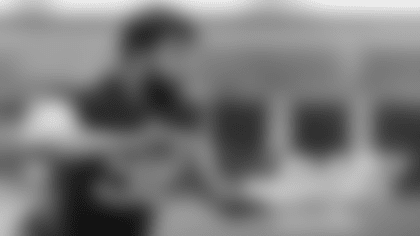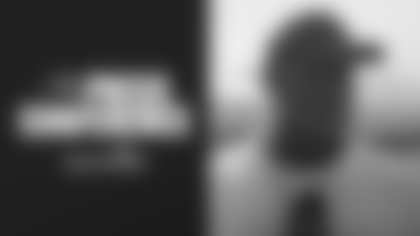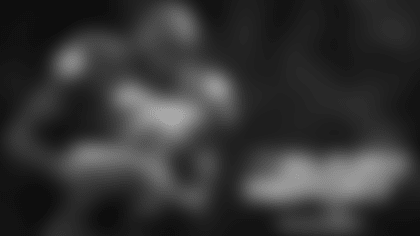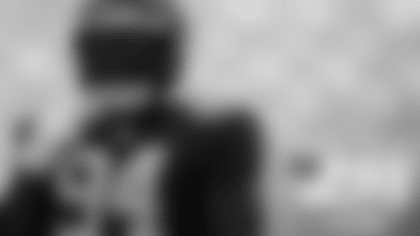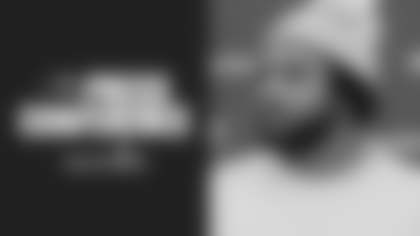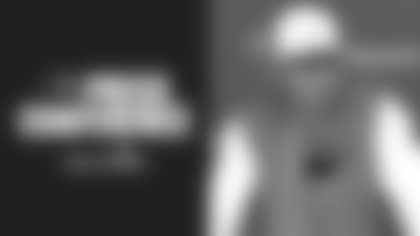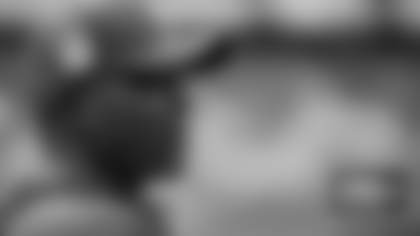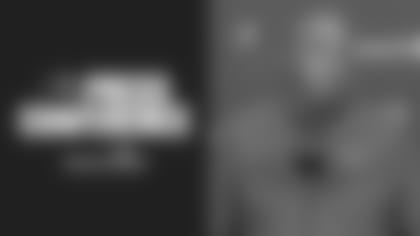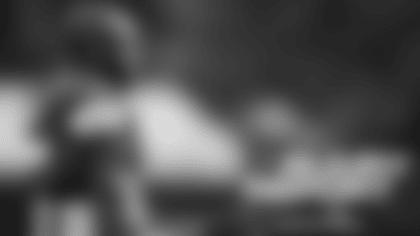Pro Bowl KR Clifton Smith put his preparation into play against Detroit in November
(Editor's Note: The following article was first published in Volume 3, Issue 10 of *Buccaneers Review, the Tampa Bay Buccaneers' groundbreaking answer to the traditional game program. Part 1 of the article is below; Part 2 will be posted on Monday.)
Returning punts in the National Football League — it's not a job for just anyone. Beyond the necessary skills of the eyes, hands and feet, a certain lack of the self-preservation instinct is almost essential. At some point it becomes second nature for the practiced return man, but how would the layman find the experience of staring up at a dot in the sky while 11 hardened men with bad intentions came streaking at him, knowing that in a moment he would be hurtling himself, against all common sense, toward those 11 men? Pro Bowl return man Clifton Smith takes us inside his head through the entire experience of returning a punt in the NFL, from the moment the ball takes flight to, in the best of cases, his feet take him into the opposing end zone. Smith also shares insight on the work that takes place even before game day to make a punt return successful.*
Tampa Bay Buccaneers rookie Clifton Smith was an undrafted free agent who in 2008 has made a stunning climb from the practice squad all the way to the Pro Bowl, as he will represent the NFC as the squad's return specialist this coming February. Returning punts is a high-risk, high-reward job that isn't for the faint of heart, and Smith recently sat down with Buccaneers Review to provide a detailed look at everything that goes into returning a punt in the NFL.
In the Buccaneers' Week 12 victory over the Detroit Lions, Smith took the field for a punt return with 11:49 to go in the third quarter.
The Lions, still looking for their first win of the season, had jumped out to a surprising 17-0 lead in the first quarter before the Bucs stormed back with 21 unanswered points in the second period. Early in the second quarter, with the game still very much in doubt, the Buccaneers' defense forced a punt with the ball at Detroit's 29-yard line. Lions punter Nick Harris caught the snap and unleashed a high, spiraling punt down the middle of the field, with Smith waiting on the other end.
Smith fielded the punt at his own 30, took a step to his left then cut hard to the right to elude the first wave of would-be tacklers. Detroit long-snapper Don Mulbach nearly tripped Smith up as he hit the seam, but Smith kept his balance and began to build up speed as his blockers cleared a path in front of him. Harris was next in line to try to stop Smith, but the Buccaneer speedster stuck his right leg hard into the turf and made a ridiculous, full-speed juke to the left that sent Harris flying harmlessly past. From there, it was nothing but open field as Smith cruised to the end zone for the Bucs' first punt return for a touchdown since 2004. It was also Smith's second special teams touchdown in three weeks, as he also brought a kickoff all the way back in Kansas City in Week Nine.
The entire return, from when the ball was snapped until Smith crossed the goal line, took about 15 seconds of real time. But the evolution of Smith's big play took much longer than that. From sunny afternoons catching fly balls as a prep baseball player to returning kicks throughout high school and college, to countless hours spent catching punts in practice and reviewing film of opponents, Smith has, in a sense, been raised to be a return man.
That's the way he views it, at least. Some players have ‘it' — the instinctive traits that are required to stand all by yourself at one end of the field, catch a ball kicked high in the air, then try to maneuver through 11 men hurtling down the field at full speed trying to knock your head off. The great ones can do it time and again, like Brian Mitchell or Eric Metcalf, or even Smith's inspiration as a kid, Deion Sanders.
Others simply don't possess that innate fearlessness, that love of the spotlight or whatever ‘it' is that drives a punt returner. Recently, Smith took a moment to sit down, close his eyes and drift off into his memory to give an in-depth look at just what goes into returning an NFL punt — everything from the week of practice leading up to the game to standing in a packed stadium awaiting the kick.
Below is the first part of Smith's account, in his own words, of what it takes to return a punt. This part will cover the preparation to the point of the play's beginning. Part 2, to be posted on Monday, will pick up the story with Smith about to field a punt:
I grew up loving to return punts, definitely. I loved returning punts and loved returning kicks. I was a huge fan of ‘Prime Time,' Deion Sanders, when I was a kid. I'm not going to say that's where the biggest highlights come from, but you can win or lose a game back there. I always like putting pressure on myself and I always thought of myself as a clutch player, so in a time of need when that fourth quarter came around and the team needed that big punt return to set the team up for the score, I always wanted to be that guy to put the spark in it.
I was always told that baseball players make the best punt returners, because if you can focus on that small ball while it's in the air and get in great body position, especially playing the outfield — and I played centerfield all through high school — that helps. You've got to know where the ball is going and make sure you catch the ball right on the top of your head. Knowing how to catch fly balls, it makes punt returns so much easier. It's just like catching a pop fly. Especially if it's high in the air and you've got the wind blowing, that ball is moving everywhere. You don't know if it's coming deeper than where it's going, or if you come up too close it might go over your head, so they always said that baseball players make the best punt returners.
I returned kicks all the way through college, but the preparation is so much more now that I'm in the NFL. During the week, for our preparation, first we focus on what the other team's coverage unit does well, what their strengths are. Then we focus on what can we do to dissect their weaknesses, where we can attack them, because everybody has a weakness. It doesn't matter how great you are, that weakness will show up on film and somebody will attack it every single time. So you've just got to look for what they do and know what they do well and know what they don't do well and attack their weaknesses.
I study both the coverage unit and the other team's punter, but definitely more so the coverage unit. You have to know the guys they have up front, how fast certain players are and what kind of releases they want to take, and also know the different fronts you throw at them and how fast they want to get out of their protection to go cover down the field. It's a lot of different variations of things you can think about.
On the sideline during the game, I stand away from everybody, probably about 40 yards behind the defense. That's pretty much where punters like to kick it to, about 40 yards away, so I stand about 40 yards back just to get a feel where I might be if the other team punts. Coach [Dwayne] Stukes comes down to me and gives me great words of encouragement, where to stand out on the field, what kind of return we're thinking about doing. So I stand away from everybody during the game.
When it's time for a return, Coach Stukes and Coach [Rich] Bisaccia talk it over and I get the call as soon as I run out on the field. As for the calls we have, it's just different directions. There's only three directions you can go on the field, so you just look for that direction and go. The first thing you look for, you just think about what their strengths were, going back to your preparation, thinking about who their strong players are on that side of the field, who you think you would have to make miss going that way and looking at what ‘flyer' is out there and how fast does he get down the field, because if the corner misses him, he's a free hitter. There's a lot of different things you think about out there.
When it comes to my positioning on the field as I'm waiting for the punt, Coach Stukes and Coach Bisaccia do a great job. Josh Bidwell also helps me out and tells me about where punters stand and by looking at the direction they stand, which way they might kick. If they stand facing a certain direction, they want to punt it across the field, punt it to your right or punt it to your left. So they kind of have great tips for me to know where to stand out on the field. As for how far away from the line of scrimmage to line up, we go through a whole ‘punter's tip' during the week and they tell you how much hang time the punter has, how far he kicks the ball. We go through that whole tip during the week, so by game time Coach Stukes and Coach Bisaccia know exactly how far he's punting. Generally you stand about 40 to 45 yards away from the line of scrimmage and that's basically where you catch the ball every time, unless you catch a guy like New Orleans' punter [Glenn Pakulak] who was kicking it 70 yards down the field when we played them a few weeks back.
There are some other things that can affect where you position yourself on the field, though, like the wind or the weather. When the ball is in the air, you've got to determine how deep it's going to go. You've got to test the wind out and know how far the wind is pushing it. Then you've got to look at the rotation of the ball. The rotation of the ball has an extra push to it. So the weather definitely has a lot to do with it.
After preparing all week, once the defense gets a stop on third down and you know the other team is going to punt, it's show time. You get back there and you're on an island, pretty much, by yourself. You're just back there all by yourself, but you've got 10 other guys out there busting their butts to get the job done with you. Back there on punt returns, I don't want to say it's the spotlight, but it really is. That can win a game or lose a game right there.
Please return on Monday for Part 2: The Return.




